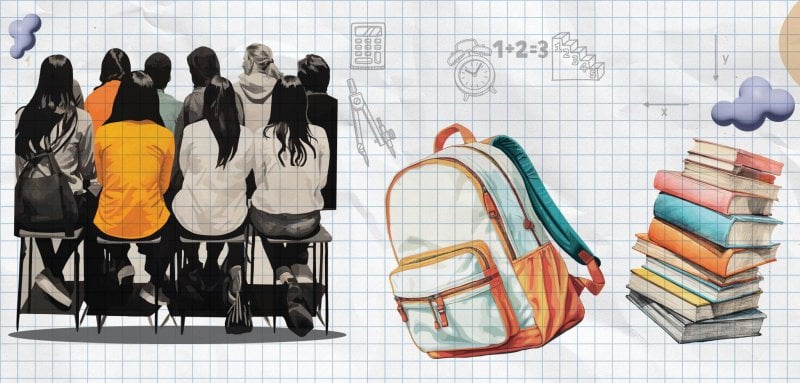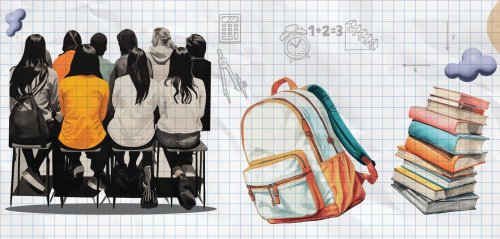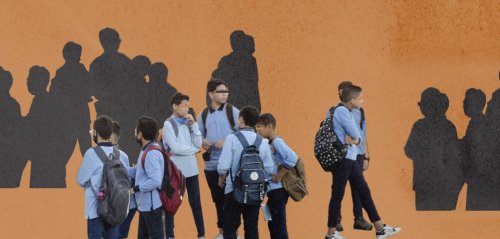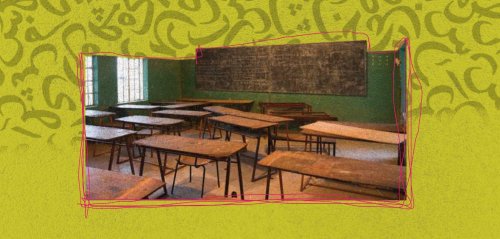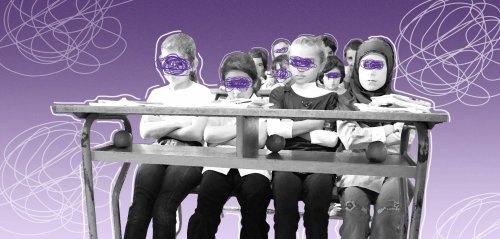Within the framework of the Syrian Crisis Response Plan (LCRP), and in collaboration with the Ministry of Education and Higher Education, UNICEF has established a comprehensive 'Education Programme'. This program's objective is to provide education to Syrian students in 342 official schools spread across various regions in Lebanon.
Under this initiative, UNICEF was previously paying $600 USD annually to the Lebanese Ministry of Education for each Syrian student attending afternoon classes and $363 USD for those enrolled in morning sessions. These funds were designated primarily for operational expenses, excluding teacher salaries, school infrastructure and upkeep costs, as well as equipment and furnishings.
However, for the academic year 2022/2023, UNICEF's contribution has experienced a substantial decline of 76.6%. Presently, UNICEF provides $140 USD for each Syrian student enrolled in both morning and afternoon education, along with an additional $18 USD for each Lebanese student in official formal education, compared to the previous $160 USD, reflecting an 89% reduction.
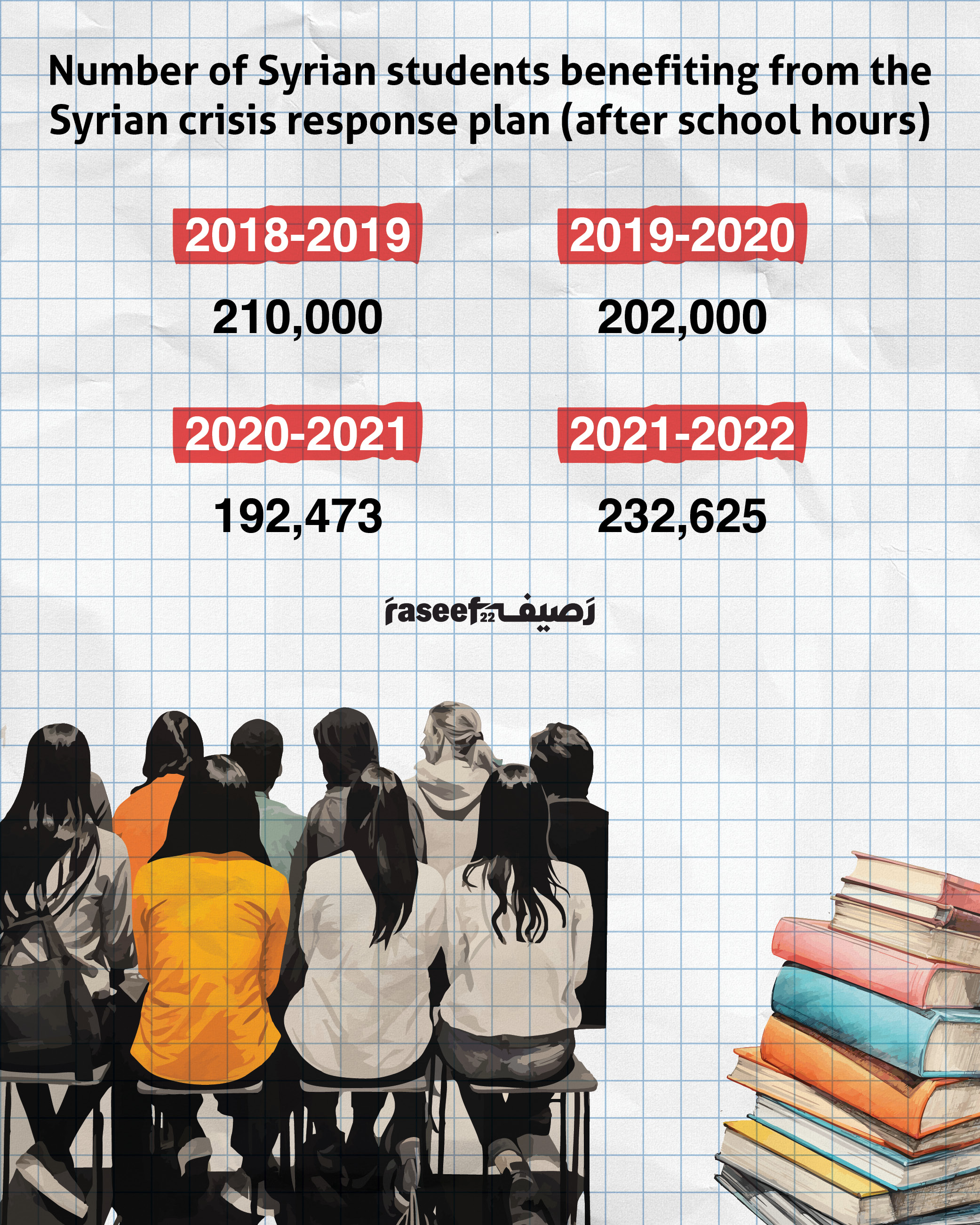 Number of Syrian students benefiting from the Syrian crisis response plan (after school hours)
Number of Syrian students benefiting from the Syrian crisis response plan (after school hours)
Lebanese students have their share as well
It's important to note that the comprehensive response plan in the education sector doesn't solely cater to Syrian children; it also encompasses marginalized and economically disadvantaged groups among the Lebanese populace, Palestinian refugees displaced from Syria, and Palestinian refugees residing in Lebanon.
The assistance provided to public schools included financial support for school funds and coverage of student registration fees for morning sessions. In the academic year 2018/2019, 68% of the total students received assistance, and this percentage increased to 88% in the academic year 2021/2022.
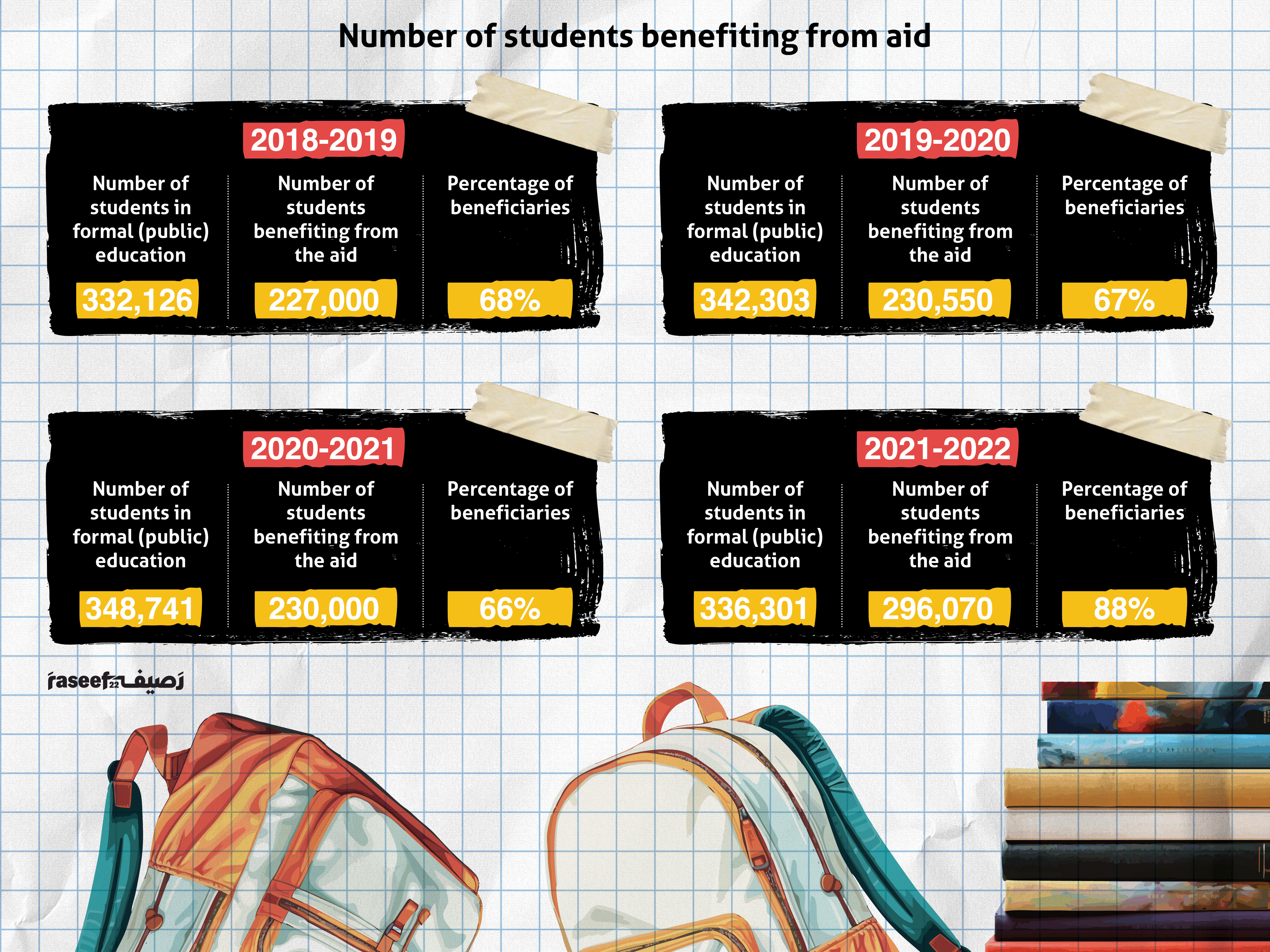 Number of students benefiting from aid and assistance
Number of students benefiting from aid and assistance
Numbers indicating the weakness of the response plan
Regarding the response plan and the enrollment of Syrian students, here are some numbers that don't bode well for the three education stages. These figures precede the significant reduction in funding during the current academic year, which will greatly impact Syrian students in the future.
In the nursery stage (3-5 years), there has been a noticeable decline in enrollment over the past three years: 16% in 2020, 11% in 2021, and a further drop to 7% in 2022. Potential factors contributing to this decline include the belief that keeping children with their families at this age is preferable or fears related to the COVID-19 pandemic.. but in the end, the result remains the same.
In primary education (6-14 years), the highest enrollment rate was 69% in 2019, while the lowest was 52% in 2021, possibly due to COVID-19 pandemic. However, 39% of this age group is currently not part of the education system, with some never having enrolled in education and many working in the labor market, in violation of Lebanese labor laws.
In secondary education (15-17 years), there has been a slight improvement in enrollment, with 28% in 2022 compared to 27% in 2021, although this remains modest compared to the 22% enrollment rate in 2019.
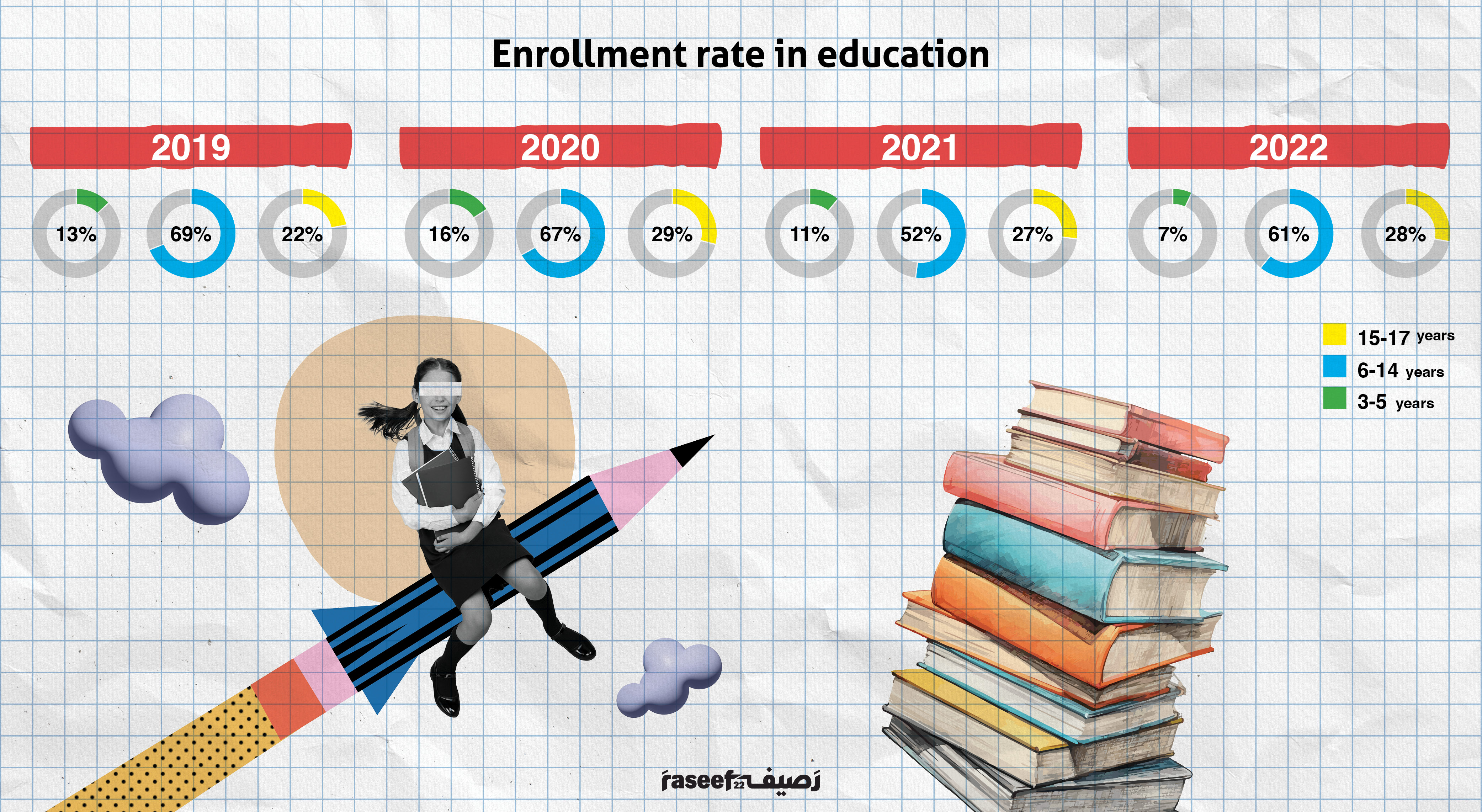 Enrollment rate in education
Enrollment rate in education
In Lebanon, there are approximately 705,000 Syrian children aged 3-17 years. However, the number of those enrolled in education is only 232,625 students. This means that the response plan has successfully enrolled only 33% of the total children, while 67% remain outside the education system. Some have entered the labor market after completing primary education, while others have never enrolled or dropped out early, leaving them vulnerable to illiteracy.
It's crucial to note that Syrian children in Lebanon face not only the pressures of the economic crisis and the effects of the COVID-19 pandemic but also the unjust policies of donor countries and UNICEF, the organization leading the education sector. These policies are evident in the significant reduction of financial support for the education process of Syrian and Lebanese students alike, with substantial implications for the academic year 2023-2024.
The many challenges Syrian students face
The economic and social circumstances of Syrian refugees are replete with factors that heighten the difficulty for students to enroll in schools. Drawing from the "Vulnerability Assessment for Syrian Refugees in Lebanon" (VASYR), six primary reasons contribute to the non-enrollment of school-age children, and these factors vary across school years and age-educational stages. However, a consistent trend in 2021 and 2022 is that the primary and secondary reasons revolve around families' incapacity to afford the mounting costs of education and transportation, with percentages ranging from 7% to 33%.
Syrian children in Lebanon face not only the pressures of the economic crisis and the repercussions of the COVID-19 pandemic, but also the unjust policies of donor countries and UNICEF, the organization leading the education sector
The third reason pertains to the challenges Syrian students encounter in adapting to the Lebanese curriculum, resulting in learning difficulties ranging from 9% to 28%. The fourth reason, linked to circumstances beyond parental control, involves the fear of contracting COVID-19, with percentages ranging from 10% to 28%. The fifth reason involves the necessity to join the workforce, with percentages ranging from 7% to 21%. The final reason relates to marriage, with percentages ranging from 7% to 10%.
 The main reasons for Syrian students not enrolling in formal education (percentage rates)
The main reasons for Syrian students not enrolling in formal education (percentage rates)
Syrian students face similar challenges as their Lebanese counterparts regarding the quality of education in public schools, a topic deserving its own discussion.
However, it is vital to underscore the compounded challenges Syrian students encountered during the period of remote learning, particularly concerning the technological aspect, which includes access to electricity, devices, and the internet. These challenges had a substantial adverse impact on the knowledge they acquired during that period.
The fact that 67% of Syrian refugee children are denied access to education is a cause for concern, sorrow, and indignation. What future awaits them in a world where their current circumstances are so harsh?
Furthermore, a significant portion of Syrian students grapple with extended power outages. In addition, 30% of them lacked access to the most basic tool for remote learning: a smartphone. Conversely, 70% of these students continued their education through smartphones, as opposed to computers or tablets, with 34% of them sharing devices with others.
In a learning environment where continuous communication with teachers is vital, poor internet connectivity emerged as another detrimental factor hindering the learning process. Around 51% of Syrian students had to contend with subpar internet connections, while 22% had no internet access at all for remote learning.
In essence, the stark reality that 67% of Syrian refugee children are excluded from the educational sphere is deeply troubling, and a cause for concern, sorrow, and indignation. What future awaits them in a world where their current circumstances are so harsh?
Note: All the figures presented in this data analysis are extracted from the Vulnerability Assessment for Syrian Refugees and the study "Impact of the COVID-19 Pandemic Closure on Access to and Quality of Education."
Raseef22 is a not for profit entity. Our focus is on quality journalism. Every contribution to the NasRaseef membership goes directly towards journalism production. We stand independent, not accepting corporate sponsorships, sponsored content or political funding.
Support our mission to keep Raseef22 available to all readers by clicking here!
Interested in writing with us? Check our pitch process here!
